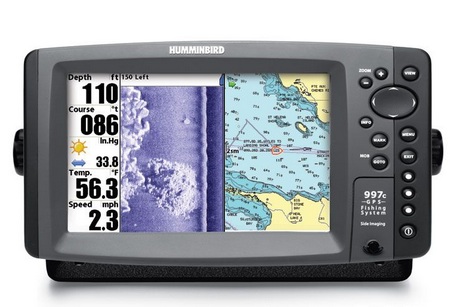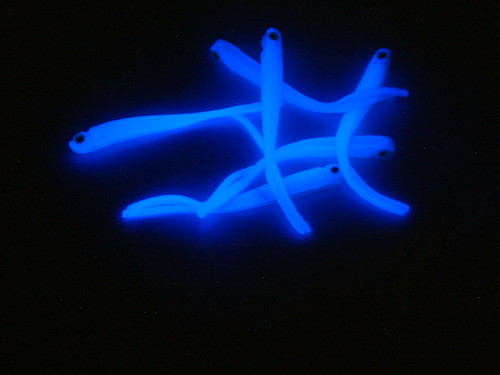Historically, ice anglers depended on clip-on lead weights to determine depth. By drilling hole after hole, anglers could drop these weights to bottom, repeatedly measure depths and eventually locate drop-offs and other underwater structures. Those with a sensitive touch could even differentiate hard bottom from soft bottom. But this was a time-consuming, often difficult task.
Today, modern sonar makes the same process relatively easy. These sensitive electronic devices feature transmitter/receivers called transducers that transmit sound waves to the bottom, receive these echos back after they bounce off bottom and return, then display these signals on a dial or screen. Once ice anglers learn to understand these displays they can easily determine depth, and by simply moving through an area and noting the depth at various points, piece together the precise location of drop-offs, underwater points, humps, holes, weeds, timber, rocks, plankton, baitfish, gamefish and differentiate bottom hardness.
The sonar available to the modern ice angler is nothing short of amazing. In fact, many anglers don't even drill holes through the ice unless they first spot gamefish with their sonar. How is that possible? By simply pouring water on solid, clear ice and placing the transducer in the water, the unit can transmit and receive sound waves through the ice, allowing you to see the depth, weeds and even fish.
Sonar Types
Sonar comes in a variety of types, but traditional flashers, liquid crystal flashers, liquid crystal graphs (LCG's) and some hand-held specialty models are the primary tools of modern ice anglers.
Traditional flashers, such as the Vexilar(r) FL-8SLT and Zercom(r) ColorPoint, show the sonar signal on a calibrated dial, which reveals depth, bottom content, cover, fish, even your lure or bait. Uniquely, flashers provide a simultaneous reaction display. In other words, if you move your lure, you see its motion displayed on the screen at the same time, providing a distinct advantage for ice anglers who want to see when fish are moving in and how they're reacting to precise presentations. Traditional flashers do, however, require a great deal of battery "juice" to power a motor and bulb, making it necessary to recharge batteries after a few days of hard use.
Liquid crystal flashers. Like traditional flashers, liquid crystal flashers display the sonar signal on a calibrated dial display and, due to some spectacular engineering feats, provide simultaneous reaction display. Some models, like the Zercom LCF-40 Ice, are custom-designed for ice fishing and feature special grade freeze-resistant display fluids. Liquid crystal flashers use much less battery juice than traditional flashers, extending battery life.
Liquid crystal graphs. LCG's display the sonar signal on a televisionlike screen made up of varying numbers of squares, called pixels, which reveal depth, bottom content, cover, fish and your lure or bait. The larger the number of pixels, the more defined the resulting picture. While close, response time is not simultaneous as it is with traditional flashers-a disadvantage when immediate response times are desired. Liquid crystal graphs also feature liquid filled screens, making them subject to freeze up if a cold-weather grade liquid is not used.
Specialty sonar: Gun-or hand-held units, such as the StrikeMaster Polar Vision, are a convenient way of determining depth and the presence of fish, but aren't as useful for providing information regarding bottom hardness and presence of cover.
Important Sonar Features
Once you've chosen the sonar style that best meets your ice-fishing needs, you'll want to consider several important features when selecting a specific unit, including portability, depth capability, transducer style and angle, power, frequency, target separation and display resolution.
Portability is crucial, because you'll need to easily carry the unit from hole to hole to locate and catch active fish. Most sonar devices marketed for the ice fisherman include either a durable plastic case or zippered carrying case.
Depth capability is the unit's ability to display signals from shallow or deep water. Most units feature several ranges, such as 0-30, 0-60, 0-120 and 0-240, and a number of modern LCG units even allow you to program the specific depth range being covered, allowing you to "zoom" in on a specific range or feature you want to view in greater detail.
Flasher colour is a flasher readout dial presented in color. The Vexilar FL-8SLT, for example, shows the strongest signals in bright red, light signals in green, and modest signals in orange, making it a very user-friendly flasher.
A transducer is the sonar device's transmitter and receiver. The primary consideration here is the unit's cone angle, which determines how large of a cone-shaped area the sonar sound waves cover. A narrow cone angle concentrates the signal strength into a small area, making it best for detecting fish holding in deep water or tight to bottom. A wide cone angle spreads the signal throughout a larger area, making it weaker, but good for covering more water, detecting suspended fish or locating fish in shallow water. Some units may feature a dual or three-way transducer, which allows you to interchange between two or more cone angles.
A self-aligning transducer is a big advantage to ice anglers, simply because the transducer is suspended in the water, causing it to automatically level itself and provide optimum readings.
Sonar power is measured in watts and determines the strength behind the sound waves being distributed to the bottom.
The more power a unit has, the more potential it has for obtaining detailed readings, including small targets in deep water. Most units run 400 to 1000 watts of power.
Frequency is measured in kilohertz (kHz) and simply determines the pattern of the sound waves being distributed and received by the transducer. Most units feature 200 kHz. The advantage of using a different frequency is simply that interference from other units is decreased or eliminated.
Target separation is the distance a transducer receiver and display screen or dial can separate targets appearing within the sonar cone. The smaller the target separation, the more clear your readings will be.
Display resolution is the ability of a calibrated dial to display the details of a signal being provided by the transducer. A liquid crystal graph with a powerful transducer and low pixel count, for example, may pick up detailed signals but not be able to fully display them.
How to Use Sonar
Often, the biggest difference between the catch of an ice-fishing expert and everyday angler is the expert's knowledgeable use of sonar. By learning how to properly read what the unit is revealing and taking advantage of that knowledge, experts vastly improve their understanding of the under-ice environment and how fish are reacting to it, then make the adjustments necessary to increase their winter catches.
To set up a flasher-type sonar for ice fishing, be sure the power button is in the "off" position, then connect your power and transducer cords to the unit, and hook up the battery. Next, set your transducer level in the hole, turn on the unit, and lower your lure about 5 feet down. Increase the gain until you clearly see the bottom and just make out your jig. Fish will now show up as they move through the sonar signal. Note that as you lower your jig deeper, you may need to turn up the gain with some units to ensure good readings.
As you spend time viewing your flasher screen, look for the following signals:
Depth appears as a solid band. On the Vexilar FL-8SLT shown below, the depth is 14 feet. Rock, gravel or sand bottoms are indicated by a second mark (double echo) at exactly twice the real depth; soft bottoms, by a wide, dim band, with no second mark.
A lure appears as a distinct, solid mark suspended at the depth you've lowered it. The gain on a Vexilar should be adjusted so the lure shows as a green or green/orange mark.
Baitfish and Plankton appear as thin marks unconnected to bottom. The Vexilar shows baitfish as thin, green marks. Because baitfish are often moving quickly, their flasher signal quivers and moves accordingly.
Weeds and other cover appear as irregular, thin, stationary marks projecting off bottom. On the Vexilar, weeds show up as thin, green marks.
Fish appear as distinct, strong, solid marks either suspended or holding just off bottom. The Vexilar indicates a fish located directly below the hole as a bright red mark.
Battery Basics
Most ice anglers have declared gel-cell batteries the winter sonar battery of choice. They're relatively lightweight, won't leak acid and can be drained and recharged numerous times without needing replacing. For best results, bring your battery inside after each use, and once the battery reaches room temperature, charge overnight to maintain the battery at peak charge. Batteries should also be charged periodically during long-term storage
Article source: gandermountain.com
Grab The Bookmarketer For Your Site





